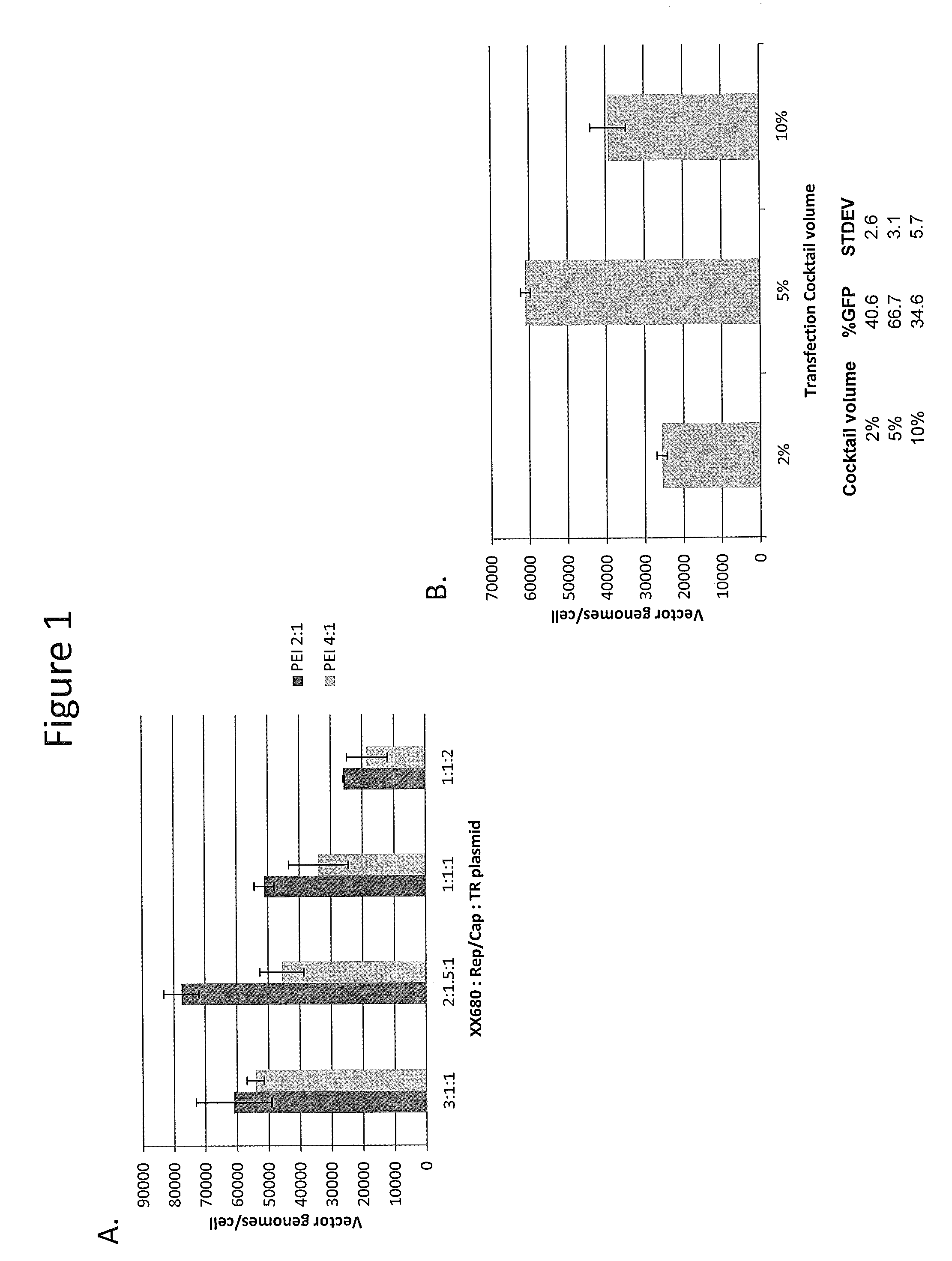Cell line for production of adeno-associated virus
a cell line and adeno-associated virus technology, applied in the field of hek293 cell line, can solve the problems of inability to replicate aav, unacceptable clinical use use, and potential for ad contamination, and achieve high titer, potent quantities of aav vectors, and high purity
- Summary
- Abstract
- Description
- Claims
- Application Information
AI Technical Summary
Benefits of technology
Problems solved by technology
Method used
Image
Examples
example 1
Materials and Methods
[0106]Derivation of Suspension HEK293 Cells from an Adherent HEK293 Qualified Master Cell Bank.
[0107]The derivation of the suspension cell line from the parental HEK293 Master Cell Bank (MCB), was performed in a Class 10,000 clean room facility. The derivation of the suspension cell line was carried out in a two phase process that involved first weaning the cells off of media containing bovine serum and then adapting the cells to serum free suspension media compatible with HEK293 cells. The suspension cell line was created as follows. First, a vial of qualified Master Cell Bank (MCB) was thawed and placed into culture in DMEM media containing 10% fetal bovine serum (FBS) and cultured for several days to allow the cells to recover from the freeze / thaw cycle. The MCB cells were cultured and passaged over a 4 week period while the amount of FBS in the tissue culture media was gradually reduced from 10% to 2.5%. The cells were then transferred from DMEM 2.5% FBS int...
example 2
Development of a Suspension HEK293 Cell Line
[0134]The purpose of this work was to generate a scalable manufacturing technology to produce high titer and highly pure rAAV using transient transfection technology and mammalian HEK293 cells. To begin, an adherent HEK293 cell line from our qualified master cell bank was adapted to grow in animal component-free and antibiotic-free suspension conditions as described in Example 1. After adaptation to animal component-free suspension conditions and selection of a compatible animal component-free suspension medium, the suspension HEK293 cell line maintained its ability for efficient transfection and rAAV production.
example 3
Optimization of Transfection Conditions
[0135]Two of the major requirements for production of rAAV using transient transfection are determining the optimal plasmid ratios of the three plasmids and the transfection reagent to total DNA ratio. The transfection reagent can be chemical based (e.g., calcium phosphate or polyethyleneimine) or biological / lipid based (e.g., 293fectin, lipofectamine, etc.). The suspension HEK293 cells were initially grown in serum free media-1 in a 30 mL volume in 125 mL shaker flasks on the day of transfection. Various ratios of XX680:Rep / Cap:TReGFP were tested with transfection reagent to DNA ratios of 2:1 and 4:1 with 1 μg DNA / mL of cells and incubated at room temperature. As shown in FIG. 1A, the plasmid ratio of 2:1.5:1 with a transfection reagent to DNA ratio of 2:1 generated the most vector genomes (vg) / cell. Vg / cell from cell lysates were determined using qPCR methods as described in Example 1. It was evident that the transfection reagent to DNA ratio...
PUM
| Property | Measurement | Unit |
|---|---|---|
| diameter | aaaaa | aaaaa |
| volume | aaaaa | aaaaa |
| volume | aaaaa | aaaaa |
Abstract
Description
Claims
Application Information
 Login to View More
Login to View More - R&D
- Intellectual Property
- Life Sciences
- Materials
- Tech Scout
- Unparalleled Data Quality
- Higher Quality Content
- 60% Fewer Hallucinations
Browse by: Latest US Patents, China's latest patents, Technical Efficacy Thesaurus, Application Domain, Technology Topic, Popular Technical Reports.
© 2025 PatSnap. All rights reserved.Legal|Privacy policy|Modern Slavery Act Transparency Statement|Sitemap|About US| Contact US: help@patsnap.com



